八年级英语上册Unit 7 Seasons Period 3 Grammar上课课件(共40张PPT)
文档属性
| 名称 | 八年级英语上册Unit 7 Seasons Period 3 Grammar上课课件(共40张PPT) | 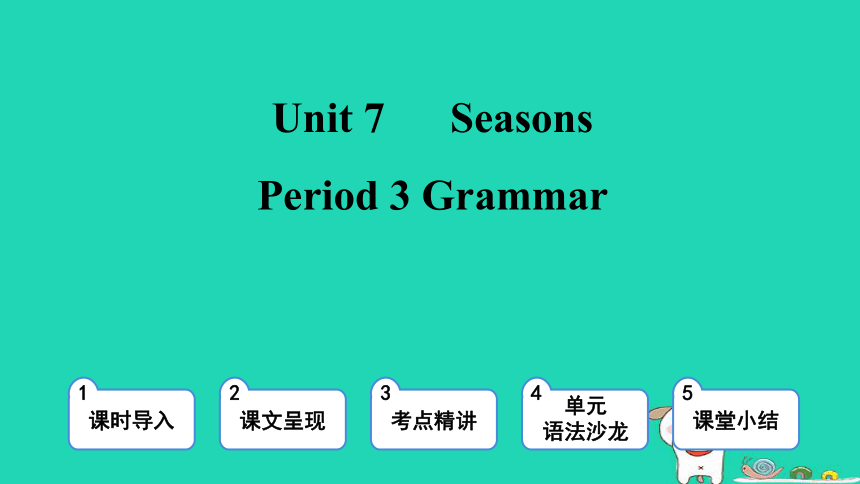 | |
| 格式 | pptx | ||
| 文件大小 | 4.0MB | ||
| 资源类型 | 教案 | ||
| 版本资源 | 牛津译林版 | ||
| 科目 | 英语 | ||
| 更新时间 | 2025-02-16 08:26:11 | ||
图片预览

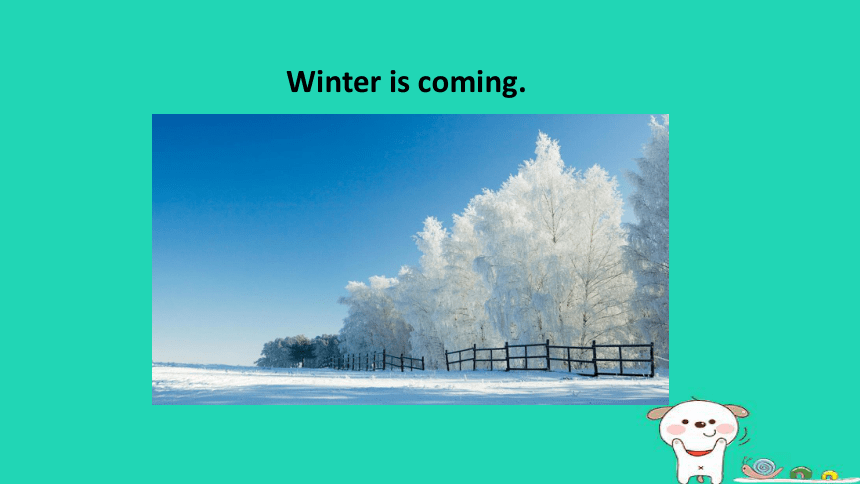
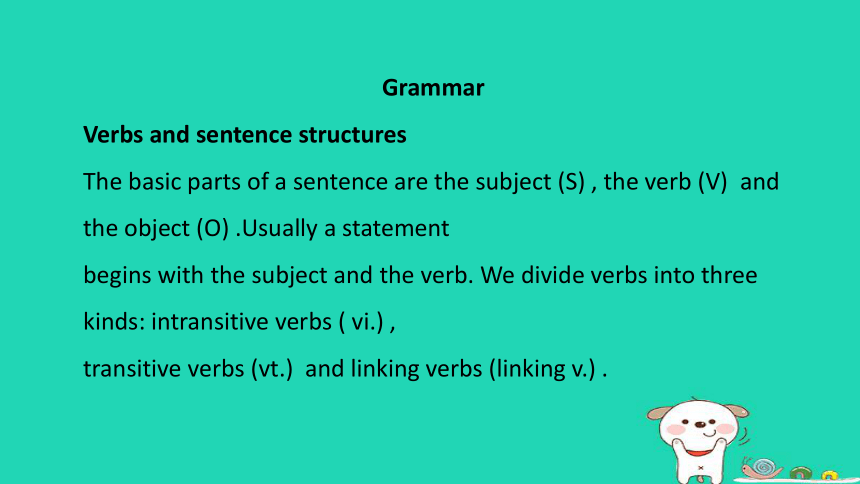


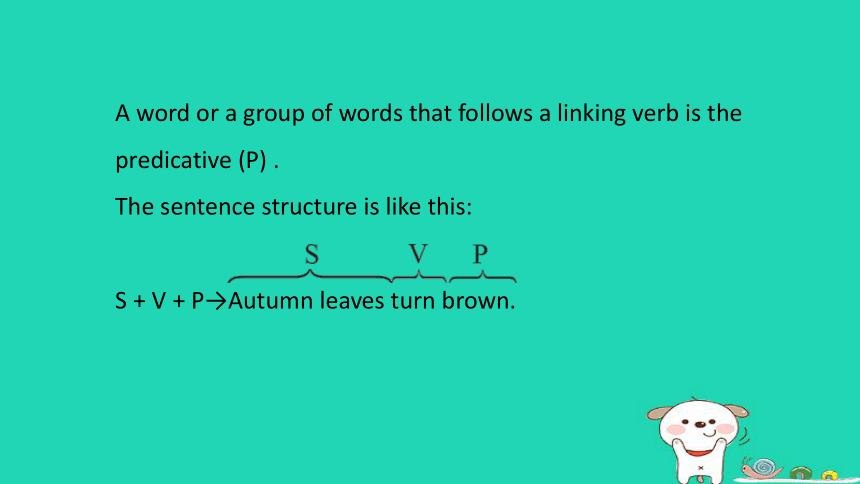


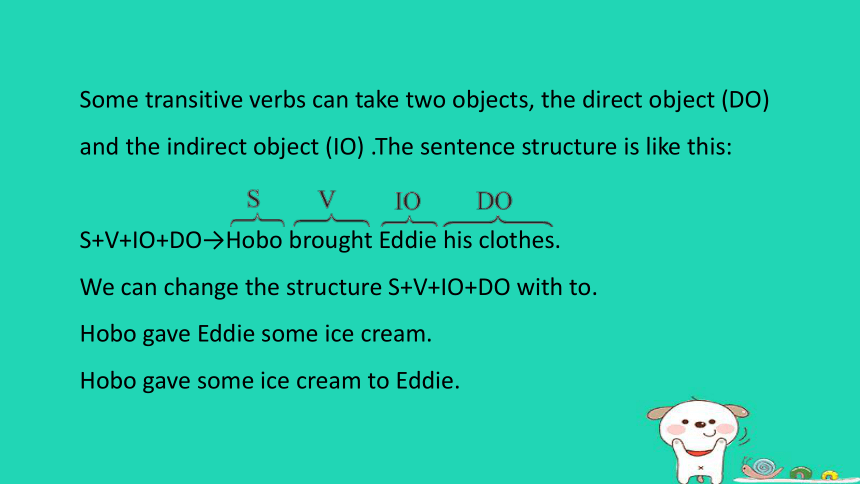
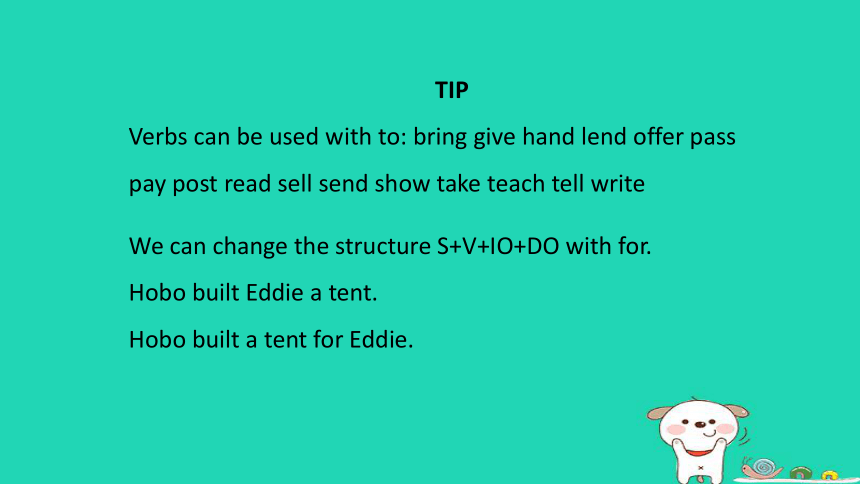
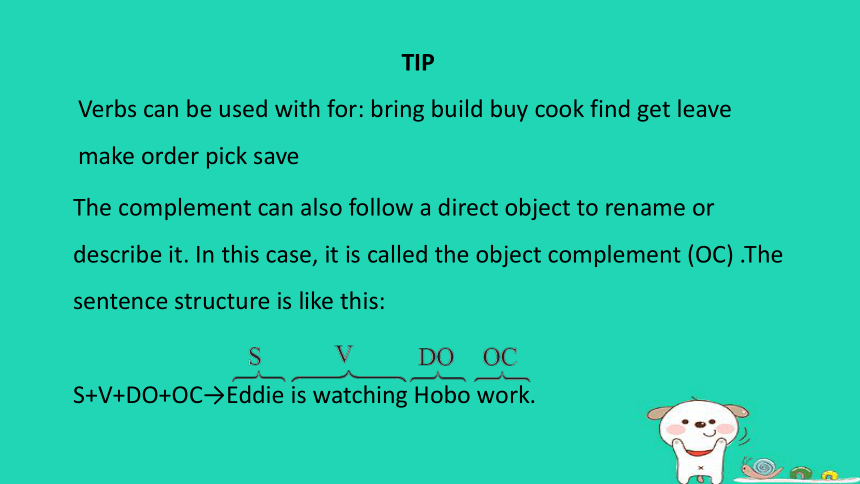
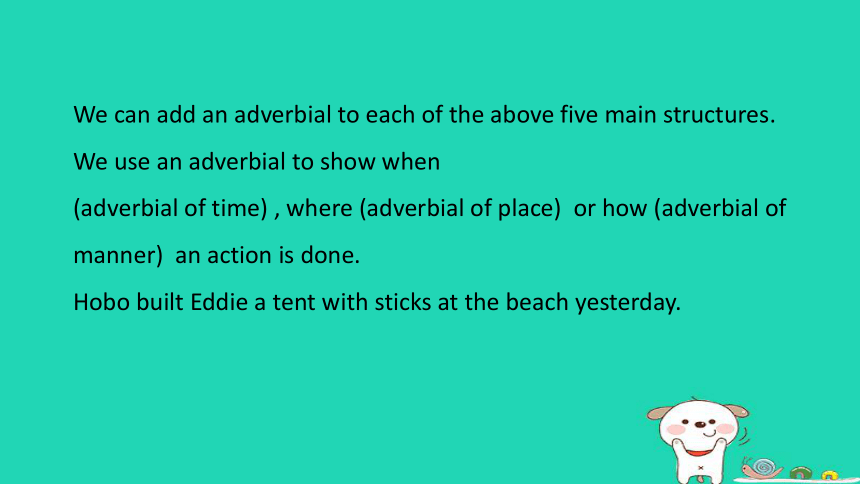
文档简介
(共40张PPT)
Unit 7 Seasons
Period 3 Grammar
1
课时导入
2
课文呈现
3
考点精讲
4
单元
语法沙龙
5
课堂小结
Winter is coming.
Grammar
Verbs and sentence structures
The basic parts of a sentence are the subject (S) , the verb (V) and the object (O) .Usually a statement
begins with the subject and the verb. We divide verbs into three kinds: intransitive verbs ( vi.) ,
transitive verbs (vt.) and linking verbs (linking v.) .
An intransitive verb does not take an object. The sentence structure is like this:
S + V → The temperature drops.
A transitive verb takes an object. The verb tells us what the subject does to something else (the object) . The sentence structure is like this:
S + V + O → Farmers harvest crops.
TIP
The subject and object can be a pronoun or a noun phrase.
A linking verb links the subject and the adjective phrase or noun phrase that describes it.
TIP
Common linking verbs are: be become feel get grow look
seem smell sound stay taste turn
A word or a group of words that follows a linking verb is the predicative (P) .
The sentence structure is like this:
S + V + P→Autumn leaves turn brown.
A. Millie is writing about the seasons. Help her underline the verb in each sentence and write down the main structure of the sentence.
1. We have four seasons. _______________
2. They are quite different. _______________
3. Spring is warm and sunny. _______________
4. We fly kites. _______________
have S+V+O
are S+V+P
is S+V+P
fly S+V+O
5. We like summer. _______________
6. Ice cream tastes nice. _______________
7. Autumn arrives. _______________
8. Snow falls. _______________
like S+V+O
tastes S+V+P
arrives S+V
falls S+V
Some transitive verbs can take two objects, the direct object (DO) and the indirect object (IO) .The sentence structure is like this:
S+V+IO+DO→Hobo brought Eddie his clothes.
We can change the structure S+V+IO+DO with to.
Hobo gave Eddie some ice cream.
Hobo gave some ice cream to Eddie.
TIP
Verbs can be used with to: bring give hand lend offer pass pay post read sell send show take teach tell write
We can change the structure S+V+IO+DO with for.
Hobo built Eddie a tent.
Hobo built a tent for Eddie.
TIP
Verbs can be used with for: bring build buy cook find get leave make order pick save
The complement can also follow a direct object to rename or describe it. In this case, it is called the object complement (OC) .The sentence structure is like this:
S+V+DO+OC→Eddie is watching Hobo work.
We can add an adverbial to each of the above five main structures. We use an adverbial to show when
(adverbial of time) , where (adverbial of place) or how (adverbial of manner) an action is done.
Hobo built Eddie a tent with sticks at the beach yesterday.
B. Amy keeps a weather diary. Read the sentences from her diary entries and describe the main structures of the underlined sentences.
1. It was a perfect day today. There was not a cloud in the sky. Mum was making breakfast for me when I woke up this morning.
2. The clouds became dark. They covered the sun. Luckily, it didn’t rain.
S + V + P S + V + O S + V
3. It was New Year’s Day. Mum and Dad gave me nice presents, but I was not happy. The rain was falling from morning till night. ① I hate rainy days.
4. The sun was shining. I saw some kids kicking the ball in the park. ② I caught a bad cold. I had a high fever and coughed a lot, so Mum took me to the hospital. ③ It was an awful day! ④
S + V + IO + DO S + V + P S + V + O
S + V + P S + V + DO + OC + adverbial
from morning till night 从早到晚
e.g. He works from morning till night every day.
他每天从早到晚工作。
Jim did his homework till 10 o’clock in the evening.
吉姆做作业直到晚上十点。
考点1
返回
知识点
1
The rain was falling from morning till night.
from...till...从……直到……
kick /k k/ vt. 踢(hit sb. / sth. with your foot)
e.g. He kicked the door hard. 他使劲地踢门。
He threw me to the ground and started to kick.
他把我摔倒在地,开始踢我。
He gave the ball a hard kick. 他使劲踢了一脚球。
考点2
kick还可作不及物动词,意为“踢”。也可作名词,意为“踢”。
n. 踢
vi. 踢
知识点
2
I saw some kids kicking the ball in the park.
kick还可作不及物动词,意为“踢”。也可作名词,意为“踢”。
返回
fever /'fi v (r) / n. 发烧(body temperature is higher than usual)
e.g. I want to see a doctor because I have a fever.
我想去看医生,因为我发烧了。
My uncle Jim had a high fever. 我叔叔吉姆发高烧了。
Let’s have a look at the TV guide and see what’s on.
咱们看看电视节目单上有什么节目。
考点3
知识点
3
I had a high fever and coughed a lot, so Mum
took me to the hospital.
常见的“have +a +名词”型短语
have a look 看一看 have a talk 谈一谈
have a try 试一试 have a rest 休息一下
have a fever 发烧
have a high/low fever发高/低烧
cough /k f/ vi.& n. 咳嗽
e.g. Cover your mouth when you cough.
你咳嗽时要捂住嘴。
You cough a lot. 你咳嗽得厉害。
She gave a little cough to attract my attention.
她轻轻地咳嗽了一声以引起我的注意。
Jason’s at home with a bad cough.
贾森咳嗽得厉害, 在家待着。
考点4
返回
have a cough 咳嗽
n. 咳嗽
awful /' fl/ adj. 糟糕的,很坏的
e.g. The weather was awful last summer.
去年夏季天气真糟糕。
I am awfully sorry to wake you up.
把你弄醒了,我感到非常抱歉。
I could tell by the look on her face that something terrible had happened.
从她的脸色我可以看出,发生了可怕的事情。
考点5
awfully 作副词,意为“非常,极其”。
知识点
4
It was an awful day!
awful 的词形转换
awful 可怕的
awfully terrible
极其,非常 可怕的;糟糕的
adv. 近义词
返回
考题:[武威、天水] — How’s the new restaurant
—It’s _____. We waited a long time for the food to arrive.
A. wonderful B. exciting
C. difficult D. awful
D
【点拨】用词义辨析法。根据问句句意“这家新饭店怎么样?”以及答语的后句句意“我们等了很长的时间食物才送到”,说明答语的前句句意是“它很糟糕”。
精彩的 令人激动的
困难的 糟糕的
简单句的五种基本句型
连系 动词 句型结构 S+V+P(主+ 系+ 表)①
连系动词 be 动词
感官动词:look,sound,smell,taste
表示“变化”的动词:become,get,grow,turn
行为 动词 不及物 动词 句型结构: S+V(主+ 谓)②
及物动词 句型结构: S+V+O(主+ 谓+ 宾)③
S+V+IO+DO(主+ 谓+ 间宾+ 直宾)④
S+V+DO+OC(主+ 谓+ 直宾+ 宾补)⑤
用于这个句型的动词是连系动词,表语用来说明主语的身份、特征和状态等。表语可以由名词、形容词、介词短语等充当。常见的连系动词有be(是),look(看上去),seem(似乎,好像),turn(变得),taste(尝起来)等。
e.g. The park looks very beautiful.
这个公园看上去很美。
考点1
考题1:[内江] The food in the restaurant is delicious. _______
A. 表语 B. 宾语
C. 主语 D. 谓语
A
【点拨】用句子分析法。画线部分形容词位于be 动词之后,充当表语。
返回
用于这个句型的动词是不及物动词,不及物动词本身意思很完整,不需要带宾语。
e.g. The children are playing happily.
孩子们正玩得开心。
考点2
返回
用于这个句型的动词是及物动词,及物动词的意思不完整,后面要带宾语才能表达完整的意思。
e.g. I like music. 我喜欢音乐。
考点3
考题2:[南京秦淮区二模] Which of the following has a different sentence structure _______
A. All the students laughed.
B. Peter is swimming in the pool.
C. Eddie is watching Hobo work.
D. The temperature will drop below zero.
S+V
S+V
S+V+DO+OC
S+V
C
返回
用于这个句型的动词是及物动词,后面跟两个(双)宾语,一个指人(间接宾语),一个指物(直接宾语)。
e.g. My mother bought me a new book yesterday.
= My mother bought a new book for me yesterday.
昨天妈妈给我买了一本新书。
考点4
特别提醒:
通常情况下,间接宾语在前,直接宾语在后。如果直接宾语在前,需要在间接宾语前加上介词to 或for。由介词to 连接间接宾语的动词有:give,lend,pass,show,send,teach 等。由介词for 连接间接宾语的动词有:buy,find,get,make,leave 等。
考题3:[宿迁沭阳县模拟] Choose the correct structure of this sentence “He gave Laura a present.” _______
A.S+V+O B. S+V+IO+DO
C.S+V+P D. S+V+DO+OC
【点拨】分析句子结构可知该句的主语为He,gave 为及物动词在句中作谓语,Laura 表示人在句中作间接宾语,a present 表示物在句中作直接宾语,故判断该句的结构为:主语+及物动词+ 间接宾语+ 直接宾语,即S+V+IO+DO。
B
返回
用于这个句型的动词是及物动词,其后的宾语可以跟宾语补足语来表明宾语的动作或状态,宾语补足语通常由形容词、名词性短语、动词的-ing形式、介词短语或动词不定式等充当。
考点5
考题4:The quiet music makes me relax. _______
A. 宾语 B. 状语 C. 宾补 D. 定语
【点拨】动词makes在句中充当谓语,me 为宾语,而画线动词relax 用来补充说明宾语的动作,为宾语补足语。
C
(1) 动词不定式作宾语补足语时通常分为以下三种情况:
①常见的接带to 的动词不定式作宾语补足语的动词有:want,ask,wish,tell,teach 等。
e.g. I want her to come here earlier.
我想她更早点儿来这里。
考题5:[镇江] The high school invited a famous scientist _______ a talk on World Earth Day.
A. giving B. to give
C. give D. given
【点拨】用语法判定法。“invite sb. to do sth.” “邀请某人干某事”,为“主语+ 谓语+ 宾语+ 宾语补足语”结构。
B
②常见的不带to 的动词不定式作宾语补足语的动词有:hear,let,see,watch 等。
e.g. I often hear her sing. 我经常听见她唱歌。
③常见的接带to 或不带to 均可的动词不定式作宾语补足语的动词是help。
e.g. She often helps her brother (to) do his homework.
她经常帮她弟弟做他的家庭作业。
(2) 常见的接动词的-ing 形式作宾语补足语的动词有hear,see,watch,keep,find 等。
e.g. I saw him crying just now. 刚才我看见他在哭。
(3) 常见的接介词短语作宾语补足语的动词有:find,put,keep 等。
e.g. The students put their hands behind their backs.
学生们把手放在他们的背后。
返回
本节课主要学习了以下知识点,请同学们及时巩固练习:
英语简单句五大基本句型
知识是力量,
梦想是翅膀。
Unit 7 Seasons
Period 3 Grammar
1
课时导入
2
课文呈现
3
考点精讲
4
单元
语法沙龙
5
课堂小结
Winter is coming.
Grammar
Verbs and sentence structures
The basic parts of a sentence are the subject (S) , the verb (V) and the object (O) .Usually a statement
begins with the subject and the verb. We divide verbs into three kinds: intransitive verbs ( vi.) ,
transitive verbs (vt.) and linking verbs (linking v.) .
An intransitive verb does not take an object. The sentence structure is like this:
S + V → The temperature drops.
A transitive verb takes an object. The verb tells us what the subject does to something else (the object) . The sentence structure is like this:
S + V + O → Farmers harvest crops.
TIP
The subject and object can be a pronoun or a noun phrase.
A linking verb links the subject and the adjective phrase or noun phrase that describes it.
TIP
Common linking verbs are: be become feel get grow look
seem smell sound stay taste turn
A word or a group of words that follows a linking verb is the predicative (P) .
The sentence structure is like this:
S + V + P→Autumn leaves turn brown.
A. Millie is writing about the seasons. Help her underline the verb in each sentence and write down the main structure of the sentence.
1. We have four seasons. _______________
2. They are quite different. _______________
3. Spring is warm and sunny. _______________
4. We fly kites. _______________
have S+V+O
are S+V+P
is S+V+P
fly S+V+O
5. We like summer. _______________
6. Ice cream tastes nice. _______________
7. Autumn arrives. _______________
8. Snow falls. _______________
like S+V+O
tastes S+V+P
arrives S+V
falls S+V
Some transitive verbs can take two objects, the direct object (DO) and the indirect object (IO) .The sentence structure is like this:
S+V+IO+DO→Hobo brought Eddie his clothes.
We can change the structure S+V+IO+DO with to.
Hobo gave Eddie some ice cream.
Hobo gave some ice cream to Eddie.
TIP
Verbs can be used with to: bring give hand lend offer pass pay post read sell send show take teach tell write
We can change the structure S+V+IO+DO with for.
Hobo built Eddie a tent.
Hobo built a tent for Eddie.
TIP
Verbs can be used with for: bring build buy cook find get leave make order pick save
The complement can also follow a direct object to rename or describe it. In this case, it is called the object complement (OC) .The sentence structure is like this:
S+V+DO+OC→Eddie is watching Hobo work.
We can add an adverbial to each of the above five main structures. We use an adverbial to show when
(adverbial of time) , where (adverbial of place) or how (adverbial of manner) an action is done.
Hobo built Eddie a tent with sticks at the beach yesterday.
B. Amy keeps a weather diary. Read the sentences from her diary entries and describe the main structures of the underlined sentences.
1. It was a perfect day today. There was not a cloud in the sky. Mum was making breakfast for me when I woke up this morning.
2. The clouds became dark. They covered the sun. Luckily, it didn’t rain.
S + V + P S + V + O S + V
3. It was New Year’s Day. Mum and Dad gave me nice presents, but I was not happy. The rain was falling from morning till night. ① I hate rainy days.
4. The sun was shining. I saw some kids kicking the ball in the park. ② I caught a bad cold. I had a high fever and coughed a lot, so Mum took me to the hospital. ③ It was an awful day! ④
S + V + IO + DO S + V + P S + V + O
S + V + P S + V + DO + OC + adverbial
from morning till night 从早到晚
e.g. He works from morning till night every day.
他每天从早到晚工作。
Jim did his homework till 10 o’clock in the evening.
吉姆做作业直到晚上十点。
考点1
返回
知识点
1
The rain was falling from morning till night.
from...till...从……直到……
kick /k k/ vt. 踢(hit sb. / sth. with your foot)
e.g. He kicked the door hard. 他使劲地踢门。
He threw me to the ground and started to kick.
他把我摔倒在地,开始踢我。
He gave the ball a hard kick. 他使劲踢了一脚球。
考点2
kick还可作不及物动词,意为“踢”。也可作名词,意为“踢”。
n. 踢
vi. 踢
知识点
2
I saw some kids kicking the ball in the park.
kick还可作不及物动词,意为“踢”。也可作名词,意为“踢”。
返回
fever /'fi v (r) / n. 发烧(body temperature is higher than usual)
e.g. I want to see a doctor because I have a fever.
我想去看医生,因为我发烧了。
My uncle Jim had a high fever. 我叔叔吉姆发高烧了。
Let’s have a look at the TV guide and see what’s on.
咱们看看电视节目单上有什么节目。
考点3
知识点
3
I had a high fever and coughed a lot, so Mum
took me to the hospital.
常见的“have +a +名词”型短语
have a look 看一看 have a talk 谈一谈
have a try 试一试 have a rest 休息一下
have a fever 发烧
have a high/low fever发高/低烧
cough /k f/ vi.& n. 咳嗽
e.g. Cover your mouth when you cough.
你咳嗽时要捂住嘴。
You cough a lot. 你咳嗽得厉害。
She gave a little cough to attract my attention.
她轻轻地咳嗽了一声以引起我的注意。
Jason’s at home with a bad cough.
贾森咳嗽得厉害, 在家待着。
考点4
返回
have a cough 咳嗽
n. 咳嗽
awful /' fl/ adj. 糟糕的,很坏的
e.g. The weather was awful last summer.
去年夏季天气真糟糕。
I am awfully sorry to wake you up.
把你弄醒了,我感到非常抱歉。
I could tell by the look on her face that something terrible had happened.
从她的脸色我可以看出,发生了可怕的事情。
考点5
awfully 作副词,意为“非常,极其”。
知识点
4
It was an awful day!
awful 的词形转换
awful 可怕的
awfully terrible
极其,非常 可怕的;糟糕的
adv. 近义词
返回
考题:[武威、天水] — How’s the new restaurant
—It’s _____. We waited a long time for the food to arrive.
A. wonderful B. exciting
C. difficult D. awful
D
【点拨】用词义辨析法。根据问句句意“这家新饭店怎么样?”以及答语的后句句意“我们等了很长的时间食物才送到”,说明答语的前句句意是“它很糟糕”。
精彩的 令人激动的
困难的 糟糕的
简单句的五种基本句型
连系 动词 句型结构 S+V+P(主+ 系+ 表)①
连系动词 be 动词
感官动词:look,sound,smell,taste
表示“变化”的动词:become,get,grow,turn
行为 动词 不及物 动词 句型结构: S+V(主+ 谓)②
及物动词 句型结构: S+V+O(主+ 谓+ 宾)③
S+V+IO+DO(主+ 谓+ 间宾+ 直宾)④
S+V+DO+OC(主+ 谓+ 直宾+ 宾补)⑤
用于这个句型的动词是连系动词,表语用来说明主语的身份、特征和状态等。表语可以由名词、形容词、介词短语等充当。常见的连系动词有be(是),look(看上去),seem(似乎,好像),turn(变得),taste(尝起来)等。
e.g. The park looks very beautiful.
这个公园看上去很美。
考点1
考题1:[内江] The food in the restaurant is delicious. _______
A. 表语 B. 宾语
C. 主语 D. 谓语
A
【点拨】用句子分析法。画线部分形容词位于be 动词之后,充当表语。
返回
用于这个句型的动词是不及物动词,不及物动词本身意思很完整,不需要带宾语。
e.g. The children are playing happily.
孩子们正玩得开心。
考点2
返回
用于这个句型的动词是及物动词,及物动词的意思不完整,后面要带宾语才能表达完整的意思。
e.g. I like music. 我喜欢音乐。
考点3
考题2:[南京秦淮区二模] Which of the following has a different sentence structure _______
A. All the students laughed.
B. Peter is swimming in the pool.
C. Eddie is watching Hobo work.
D. The temperature will drop below zero.
S+V
S+V
S+V+DO+OC
S+V
C
返回
用于这个句型的动词是及物动词,后面跟两个(双)宾语,一个指人(间接宾语),一个指物(直接宾语)。
e.g. My mother bought me a new book yesterday.
= My mother bought a new book for me yesterday.
昨天妈妈给我买了一本新书。
考点4
特别提醒:
通常情况下,间接宾语在前,直接宾语在后。如果直接宾语在前,需要在间接宾语前加上介词to 或for。由介词to 连接间接宾语的动词有:give,lend,pass,show,send,teach 等。由介词for 连接间接宾语的动词有:buy,find,get,make,leave 等。
考题3:[宿迁沭阳县模拟] Choose the correct structure of this sentence “He gave Laura a present.” _______
A.S+V+O B. S+V+IO+DO
C.S+V+P D. S+V+DO+OC
【点拨】分析句子结构可知该句的主语为He,gave 为及物动词在句中作谓语,Laura 表示人在句中作间接宾语,a present 表示物在句中作直接宾语,故判断该句的结构为:主语+及物动词+ 间接宾语+ 直接宾语,即S+V+IO+DO。
B
返回
用于这个句型的动词是及物动词,其后的宾语可以跟宾语补足语来表明宾语的动作或状态,宾语补足语通常由形容词、名词性短语、动词的-ing形式、介词短语或动词不定式等充当。
考点5
考题4:The quiet music makes me relax. _______
A. 宾语 B. 状语 C. 宾补 D. 定语
【点拨】动词makes在句中充当谓语,me 为宾语,而画线动词relax 用来补充说明宾语的动作,为宾语补足语。
C
(1) 动词不定式作宾语补足语时通常分为以下三种情况:
①常见的接带to 的动词不定式作宾语补足语的动词有:want,ask,wish,tell,teach 等。
e.g. I want her to come here earlier.
我想她更早点儿来这里。
考题5:[镇江] The high school invited a famous scientist _______ a talk on World Earth Day.
A. giving B. to give
C. give D. given
【点拨】用语法判定法。“invite sb. to do sth.” “邀请某人干某事”,为“主语+ 谓语+ 宾语+ 宾语补足语”结构。
B
②常见的不带to 的动词不定式作宾语补足语的动词有:hear,let,see,watch 等。
e.g. I often hear her sing. 我经常听见她唱歌。
③常见的接带to 或不带to 均可的动词不定式作宾语补足语的动词是help。
e.g. She often helps her brother (to) do his homework.
她经常帮她弟弟做他的家庭作业。
(2) 常见的接动词的-ing 形式作宾语补足语的动词有hear,see,watch,keep,find 等。
e.g. I saw him crying just now. 刚才我看见他在哭。
(3) 常见的接介词短语作宾语补足语的动词有:find,put,keep 等。
e.g. The students put their hands behind their backs.
学生们把手放在他们的背后。
返回
本节课主要学习了以下知识点,请同学们及时巩固练习:
英语简单句五大基本句型
知识是力量,
梦想是翅膀。
